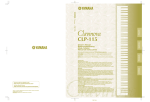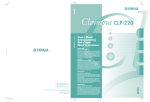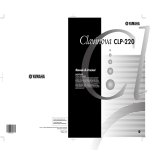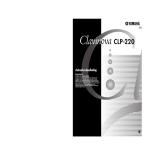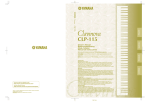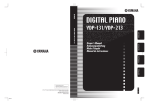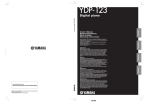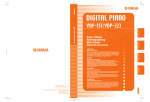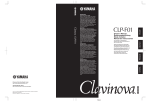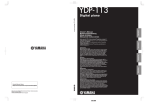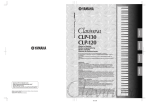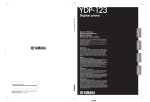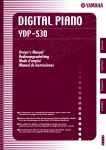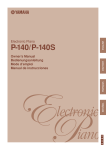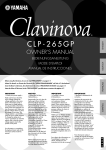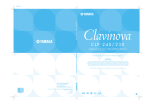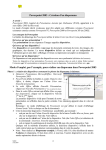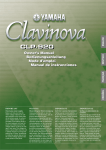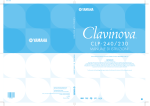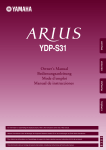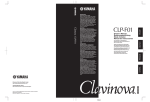Download Yamaha K-220 Owner`s manual
Transcript
Make sure that your local AC mains voltage matches the voltage specified on the name plate on the bottom panel. In some areas a voltage selector may be provided on the bottom panel of the main keyboard unit near the power cord. Make sure that the voltage selector is set for the voltage in your area. The voltage selector is set at 240V when the unit is initially shipped. To change the setting use a "minus" screwdriver to rotate the selector dial so that the correct voltage appears next to the pointer on the panel. WICHTIG Überprüfung der Stromversorgung Vergewissern Sie sich vor dem Anschließen an das Stromnetz, daß die örtliche Netzspannung den Betriebsspannungswerten auf dem Typenschild an der Unterseite des Instruments entspricht. In bestimmten Verkaufsgebieten ist das Instrument mit einem Spannungswähler an der Unterseite neben der Netzkabeldurchführung ausgestattet. Falls vorhanden, muß der Spannungswähler auf die örtliche Netzspannung eingestellt werden. Der Spannungswähler wurde werkseitig auf 240 V voreingestellt. Zum Verstellen drehen Sie den Spannungsregler mit einem Schlitzschraubendreher, bis der Zeiger auf den korrekten Spannungswert weist. IMPORTANT Contrôler la source d'alimentation Clavinova Web site (English only) http://www.yamahaclavinova.com/ Yamaha Manual Library http://www.yamaha.co.jp/manual/ U.R.G., Pro Audio & Digital Musical Instrument Division, Yamaha Corporation © 2005 Yamaha Corporation WE93800 506APAP?.?-01A0 Printed in ????? DIC413 FRANÇAIS IMPORTANT Check your power supply ESPAÑOL CLP-220 Owner's Manual Bedienungsanleitung Mode d'emploi Manual de instrucciones DEUTSCH ENGLISH CLP-220 Vérifiez que la tension spécifiée sur le panneau inférieur correspond à la tension du secteur. Dans certaines régions, l'instrument peut être équipé d'un sélecteur de tension situé sur le panneau inférieur du clavier à proximité du cordon d'alimentation. Vérifiez que ce sélecteur est bien réglé en fonction de la tension secteur de votre région. Le sélecteur de tension est réglé sur 240 V au départ d'usine. Pour modifier ce réglage, utilisez un tournevis à lame plate pour tourner le sélecteur afin de mettre l'indication correspondant à la tension de votre région vis à vis du repère triangulaire situé sur le panneau. IMPORTANTE Verifique la alimentación de corriente Asegúrese de que tensión de alimentación de CA de su área corresponde con la tensión especificada en la placa de características del panel inferior. En algunas zonas puede haberse incorporado un selector de tensión en el panel inferior de la unidad del teclado principal, cerca del cable de alimentación. Asegúrese de que el selector de tensión esté ajustado a la tensión de su área. El selector de tensión se ajusta a 240V cuando la unidad sale de fábrica. Para cambiar el ajuste, emplee un destornillador de cabeza "recta" para girar el selector de modo que aparezca la tensión correcta al lado del indicador del panel. EN DE FR ES Introduction SPECIAL MESSAGE SECTION PRODUCT SAFETY MARKINGS: Yamaha electronic products may have either labels similar to the graphics shown below or molded/stamped facsimiles of these graphics on the enclosure. The explanation of these graphics appears on this page. Please observe all cautions indicated on this page and those indicated in the safety instruction section. CAUTION RISK OF ELECTRIC SHOCK DO NOT OPEN CAUTION: TO REDUCE THE RISK OF ELECTRIC SHOCK. DO NOT REMOVE COVER (OR BACK). NO USER-SERVICEABLE PARTS INSIDE. REFER SERVICING TO QUALIFIED SERVICE PERSONNEL. See bottom of Keyboard enclosure for graphic symbol markings. The exclamation point within the equilateral triangle is intended to alert the user to the presence of important operating and maintenance (servicing) instructions in the literature accompanying the product. The lightning flash with arrowhead symbol, within the equilateral triangle, is intended to alert the user to the presence of uninsulated “dangerous voltage” within the product’s enclosure that may be of sufficient magnitude to constitute a risk of electrical shock. Battery Notice: This product MAY contain a small non- rechargable battery which (if applicable) is soldered in place. The average life span of this type of battery is approximately five years. When replacement becomes necessary, contact a qualified service representative to perform the replacement. Warning: Do not attempt to recharge, disassemble, or incinerate this type of battery. Keep all batteries away from children. Dispose of used batteries promptly and as regulated by applicable laws. Note: In some areas, the servicer is required by law to return the defective parts. However, you do have the option of having the servicer dispose of these parts for you. Disposal Notice: Should this product become damaged beyond repair, or for some reason its useful life is considered to be at an end, please observe all local, state, and federal regulations that relate to the disposal of products that contain lead, batteries, plastics, etc. NOTICE: Service charges incurred due to lack of knowl- edge relating to how a function or effect works (when the unit is operating as designed) are not covered by the manufacturer’s warranty, and are therefore the owners responsibility. Please study this manual carefully and consult your dealer before requesting service. NAME PLATE LOCATION: The graphic below indicates the location of the name plate. The model number, serial number, power requirements, etc., are located on this plate. You should record the model number, serial number, and the date of purchase in the spaces provided below and retain this manual as a permanent record of your purchase. IMPORTANT NOTICE: All Yamaha electronic products are tested and approved by an independent safety testing laboratory in order that you may be sure that when it is properly installed and used in its normal and customary manner, all foreseeable risks have been eliminated. DO NOT modify this unit or commission others to do so unless specifically authorized by Yamaha. Product performance and/or safety standards may be diminished. Claims filed under the expressed warranty may be denied if the unit is/has been modified. Implied warranties may also be affected. SPECIFICATIONS SUBJECT TO CHANGE: The information contained in this manual is believed to be correct at the time of printing. However, Yamaha reserves the right to change or modify any of the specifications without notice or obligation to update existing units. CLP-220 Model ENVIRONMENTAL ISSUES: Yamaha strives to pro- duce products that are both user safe and environmentally friendly. We sincerely believe that our products and the production methods used to produce them, meet these goals. In keeping with both the letter and the spirit of the law, we want you to be aware of the following: 92-469 1 (bottom) Serial No. Purchase Date PRECAUTIONS PLEASE READ CAREFULLY BEFORE PROCEEDING * Please keep this manual in a safe place for future reference. WARNING Always follow the basic precautions listed below to avoid the possibility of serious injury or even death from electrical shock, short-circuiting, damages, fire or other hazards. These precautions include, but are not limited to, the following: Water warning • Only use the voltage specified as correct for the instrument. The required voltage is printed on the name plate of the instrument. • Check the electric plug periodically and remove any dirt or dust which may have accumulated on it. • Do not expose the instrument to rain, use it near water or in damp or wet conditions, or place containers on it containing liquids which might spill into any openings. • Never insert or remove an electric plug with wet hands. • Use only the supplied power cord/plug. • Do not place the power cord near heat sources such as heaters or radiators, and do not excessively bend or otherwise damage the cord, place heavy objects on it, or place it in a position where anyone could walk on, trip over, or roll anything over it. Fire warning ENGLISH Power supply/Power cord • Do not put burning items, such as candles, on the unit. A burning item may fall over and cause a fire. If you notice any abnormality Do not open • Do not open the instrument or attempt to disassemble the internal parts or modify them in any way. The instrument contains no user-serviceable parts. If it should appear to be malfunctioning, discontinue use immediately and have it inspected by qualified Yamaha service personnel. • If the power cord or plug becomes frayed or damaged, or if there is a sudden loss of sound during use of the instrument, or if any unusual smells or smoke should appear to be caused by it, immediately turn off the power switch, disconnect the electric plug from the outlet, and have the instrument inspected by qualified Yamaha service personnel. CAUTION Always follow the basic precautions listed below to avoid the possibility of physical injury to you or others, or damage to the instrument or other property. These precautions include, but are not limited to, the following: Power supply/Power cord Location • When removing the electric plug from the instrument or an outlet, always hold the plug itself and not the cord. Pulling by the cord can damage it. • Remove the electric plug from the outlet when the instrument is not to be used for extended periods of time, or during electrical storms. • Do not expose the instrument to excessive dust or vibrations, or extreme cold or heat (such as in direct sunlight, near a heater, or in a car during the day) to prevent the possibility of panel disfiguration or damage to the internal components. • Do not connect the instrument to an electrical outlet using a multiple-connector. Doing so can result in lower sound quality, or possibly cause overheating in the outlet. • Do not use the instrument in the vicinity of a TV, radio, stereo equipment, mobile phone, or other electric devices. Otherwise, the instrument, TV, or radio may generate noise. • Do not place the instrument in an unstable position where it might accidentally fall over. Assembly • Before moving the instrument, remove all connected cables. • Read carefully the attached documentation explaining the assembly process. Failure to assemble the instrument in the proper sequence might result in damage to the instrument or even injury. • When setting up the instrument, make sure that the AC outlet you are using is easily accessible. If some trouble or malfunction occurs, immediately turn off the power switch and disconnect the plug from the outlet. 2/2 1 (1)B-9 CLP-220 3 Connections Using the bench (If included) • Before connecting the instrument to other electronic components, turn off the power for all components. Before turning the power on or off for all components, set all volume levels to minimum. Also, be sure to set the volumes of all components at their minimum levels and gradually raise the volume controls while playing the instrument to set the desired listening level. • Do not play carelessly with or stand on the bench. Using it as a tool or stepladder or for any other purpose might result in accident or injury. • Only one person should sit on the bench at a time, in order to prevent the possibility of accident or injury. Maintenance • When cleaning the instrument, use a soft, dry or slightly damp cloth. Do not use paint thinners, solvents, cleaning fluids, or chemical-impregnated wiping cloths. • If the bench screws become loose due to extensive long-term use, tighten them periodically using the included tool. Saving data Saving and backing up your data Handling caution • Take care that the key cover does not pinch your fingers, and do not insert a finger or hand in any gaps on the key cover or instrument. ENGLISH • Do not place the bench in an unstable position where it might accidentally fall over. • Never insert or drop paper, metallic, or other objects into the gaps on the key cover, panel or keyboard. If this happens, turn off the power immediately and unplug the power cord from the AC outlet. Then have the instrument inspected by qualified Yamaha service personnel. • Data in the instrument’s internal memory can be lost due to operational errors or malfunction. Be sure to save any important data to external media via a computer connected to the instrument. (page 31) • Do not place vinyl, plastic or rubber objects on the instrument, since this might discolor the panel or keyboard. • Do not rest your weight on, or place heavy objects on the instrument, and do not use excessive force on the buttons, switches or connectors. • Do not operate the instrument for a long period of time at a high or uncomfortable volume level, since this can cause permanent hearing loss. If you experience any hearing loss or ringing in the ears, consult a physician. Yamaha cannot be held responsible for damage caused by improper use or modifications to the instrument, or data that is lost or destroyed. Always turn the power off when the instrument is not in use. (1)B-9 1/2 2 4 CLP-220 Welcome Thank you for purchasing the Yamaha Clavinova! We recommend that you read this manual carefully so that you can take full advantage of the advanced and convenient functions of your new Clavinova. We also recommend that you keep this manual in a safe, convenient place for future reference. About this Owner’s Manual Introduction (page 2): Please read this section first. Reference (page 13): This section explains how to make detailed settings for the Clavinova’s various functions. ENGLISH This manual consists of three main sections: “Introduction,” “Reference” and “Appendix.” Appendix (page 39): This section introduces reference material. * The model CLP-220 will be referred to as the CLP/Clavinova in this owner’s manual. * The illustrations as shown in this owner’s manual are for instructional purposes only, and may be different from the ones on your instrument. COPYRIGHT NOTICE This product incorporates and bundles computer programs and contents in which Yamaha owns copyrights or with respect to which it has license to use others’ copyrights. Such copyrighted materials include, without limitation, all computer software, MIDI files and WAVE data. Any unauthorized use of such programs and contents outside of personal use is not permitted under relevant laws. Any violation of copyright has legal consequences. DON’T MAKE, DISTRIBUTE OR USE ILLEGAL COPIES. Copying of the commercially available software is strictly prohibited except for your personal use. Trademarks: Apple and Macintosh are trademarks of Apple Computer, Inc. Windows is a registered trademark of Microsoft® Corporation. All other trademarks are the property of their respective holders. 3 • • • CLP-220 About this Owner’s Manual 5 Table of Contents Introduction SPECIAL MESSAGE SECTION ...................... 2 PRECAUTIONS............................................ 3 About this Owner’s Manual ........................ 5 Application Index........................................ 7 ENGLISH Accessories .................................................. 8 Maintenance ............................................... 8 Features....................................................... 9 Before Using the Clavinova ...................... 10 Key Cover ...........................................................10 Music Rest ..........................................................10 Turning the Power On.......................................11 Setting the Volume.............................................12 Using Headphones .............................................12 Transmitting Song Data between the Computer and the Clavinova ................. 31 Loading Song Data from a Computer to the Clavinova ....................................................... 31 Transmitting Song Data from the Clavinova to a Computer ............................................... 31 Backing up Data and Initializing the Settings .. 32 Troubleshooting........................................ 33 Options ...................................................... 33 Keyboard Stand Assembly ........................ 34 Index.......................................................... 37 Appendix MIDI Data Format ..................................... 40 MIDI Implementation Chart ..................... 44 Reference Specifications ............................................ 45 Part Names................................................ 14 Listening to the Demo Songs ................... 15 Listening to 50 Piano Preset Songs .......... 16 Listening to Songs Loaded from the Computer ............................................... 17 Selecting & Playing Voices........................ 18 Selecting Voices ..................................................18 Using the Pedals .................................................19 Adding Variations to the Sound – Reverb ........20 Layering Two Voices (Dual mode) ...................21 Transposition .....................................................22 Fine-tuning the Pitch .........................................22 Using the Metronome........................................23 Adjusting the Keyboard Touch (Touch Sensitivity) ........................................24 Recording your Performance.................... 25 Playing Back Recorded Performance Data .......26 Connecting MIDI Instruments .................. 27 About MIDI........................................................27 MIDI’s Capability...............................................27 Connecting the Clavinova to a Computer.. 28 MIDI Functions.......................................... 29 MIDI Transmit/Receive Channel Selection......29 Local Control ON/OFF......................................29 Program Change ON/OFF.................................30 Control Change ON/OFF ..................................30 4 6 CLP-220 Table of Contents Application Index Use this index to find reference pages that may be helpful for your particular application and situation. Listening Listening to demo songs with different voices...................................................... “Listening to the Demo Songs” on page 15 Listening to songs from “50 Greats for the Piano” ...................................... “Listening to 50 Piano Preset Songs” on page 16 Listening to recorded performances................................................. “Playing Back Recorded Performance Data” on page 26 Listening to songs loaded from the computer ......................... “Listening to Songs Loaded from the Computer” on page 17 Using three pedals ....................................................................................................................... “Using the Pedals” on page 19 Shifting the pitch of the keyboard up or down in semitone steps ................................................ “Transposition” on page 22 Fine-tuning the pitch of the entire instrument when you play the Clavinova along with other instruments or CD music.......................................................................“Fine-tuning the Pitch” on page 22 Adjusting the key touch response (sensitivity) for changing the volume .............................................................................................. “Adjusting the Keyboard Touch (Touch Sensitivity)” on page 24 ENGLISH Playing Changing voices Viewing the list of voices............................................................................................................. “Selecting Voices” on page 18 Simulating a concert hall .................................................................... “Adding Variations to the Sound – Reverb” on page 20 Combining two voices.................................................................................... “Layering Two Voices (Dual mode)” on page 21 Practicing Practicing with an accurate and steady tempo .................................................................“Using the Metronome” on page 23 Recording Recording your performances ............................................................................... “Recording your Performance” on page 25 Connecting the Clavinova to other devices What is MIDI? ..................................................................................................... “Connecting MIDI Instruments” on page 27 Connecting the computer ..................................................................“Connecting the Clavinova to a Computer” on page 28 Transmitting the recording of your performance to a computer ............................................................................... “Transmitting Song Data from the Clavinova to a Computer” on page 31 Transmitting song data from a computer to the Clavinova ....................................................................................... “Loading Song Data from a Computer to the Clavinova” on page 31 Assembling 5 Assembling and disassembling the Clavinova ....................................................“Keyboard Stand Assembly” on pages 34–36 CLP-220 Application Index 7 Accessories • “50 Greats for the Piano” (Music Book) • Owner’s Manual This manual contains complete instructions for operating your Clavinova. • Quick Guide ENGLISH • Headphone hanger set • Assembly parts Maintenance Clean the instrument using a dry or slightly damp soft cloth (wring well). CAUTION Do not use benzene, thinner, detergent, or chemically-treated cloth for cleaning. Do not place vinyl, plastic or rubber products on the instrument. Otherwise, the panel or keys may become discolored or degraded. CAUTION Before using the Clavinova, be sure to read “Precautions” on pages 3 – 4. Tuning Unlike an acoustic piano, the Clavinova does not need to be tuned. It always stays perfectly in tune. Transporting If you move to another location, you can transport the Clavinova along with your other belongings. You can move the unit as it is (assembled) or you can disassemble the unit before moving. Transport the keyboard horizontally. Do not lean it up against a wall or stand it up on its side. Do not subject the instrument to excessive vibration or shock. 6 8 CLP-220 Accessories Features The Yamaha Clavinova CLP-220 digital piano offers unmatched sonic realism and natural grand-piano type playability as well as Yamaha’s original “AWM Stereo Sampling” tone-generation technology for rich, musical voices, and a special “Graded Hammer” keyboard that provides graded key weight and response throughout the keyboard range. Two of the piano voices, “Grand Piano 1” and “Grand Piano 2,” feature totally new samples recorded from a full-size concert grand piano. The “Electric Piano 1” voice features multiple samples for different velocities (Dynamic Sampling); that is, different samples are used depending on how fast or strong you strike the keys. The CLP-220 sounds much closer to a true acoustic piano. MIDI [IN/OUT] A set of standard stereo headphones can be plugged in here for private practice (page 12). Connect a MIDI device to this connector to use various MIDI functions (pages 27–28). (Connecting MIDI Instruments—page 27) ENGLISH ........ ...... [PHONES] PEDAL MIDI ........ PHONES [PEDAL] OUT Connect the pedal cord (page 35). IN POWER [DEMO/SONG] Listen to the playback of a demo song for each voice and 50 piano preset songs (page 15). [PIANO/VOICE] ........ Select one of 10 internal sounds, including Grand Piano 1 and 2 (page 18). You can also layer two voices together (page 21) or select various reverb effects (page 20). [REC] ........ Record your performance (page 25). [PLAY] Select a demo song for each voice, or one of the 50 piano preset songs (page 15 and 16). You can also select a different voice while the song playback is stopped. ........ [METRONOME] ........ ........ Control the metronome functions (page 23). [MASTER VOLUME] Adjust the volume level using this control (page 12). 7 Play back your recorded performance (page 26). [SELECT] CLP-220 Features 9 Before Using the Clavinova Key Cover To open the key cover: Lift the cover slightly, then push and slide it open. To close the key cover: ENGLISH Slide the cover toward you and gently lower the cover over the keys. CAUTION Be careful to avoid catching your fingers when opening or closing the cover. CAUTION Hold the cover with both hands when opening or closing it. Do not release it until it is fully opened or closed. Be careful to avoid catching fingers (yours or others, especially children’s) between the cover and main unit. CAUTION Do not place objects, such as a piece of metal or paper, on top of the key cover. Small objects placed on the key cover may fall inside the unit when the cover is opened and may be nearly impossible to remove. This could cause electric shock, short circuit, fire or other serious damage to the instrument. Music Rest To raise the music rest: 1. Pull the music rest up and toward yourself as far as it will go. 2. Flip down the two metal supports at the left and right on the rear of the music rest. 3. Lower the music rest so that it rests on the metal supports. To lower the music rest: 1. Pull the music rest toward yourself as far as it will go. 2. Raise the two metal supports (at the rear of the music rest). 3. Gently lower the music rest backward until it is all the way down. CAUTION Do not try to use the music rest in a half-raised position. When lowering the music rest, do not release your hands from the music rest until it is all the way down. 8 10 CLP-220 Before Using the Clavinova Turning the Power On 1. Connect the power cord. Insert the plugs at the ends of the cord: one into the AC INLET on the Clavinova, and the other into a standard AC outlet. In some areas, a plug adaptor may be provided to match the pin configuration of AC wall outlets in your area. 1 2 (The shape of the plug differs depending on locale.) CAUTION ENGLISH (bottom surface) Make sure your CLP-220 is rated for the AC voltage supplied in the area in which the piano will be used. (The voltage rating appears on the name plate on the bottom panel). In some areas, a voltage selector may be provided on the bottom panel of the main keyboard unit near the power cord. Make sure that the voltage selector is set for the voltage in your area. Connecting the unit to an inappropriate AC supply can seriously damage the internal circuitry and may even pose a shock hazard! Use only the AC power cord supplied with the CLP-220. If the supplied power cord is lost or damaged and needs to be replaced, contact your Yamaha dealer. The use of an inappropriate replacement can pose a fire and shock hazard! The type of AC power cord provided with the CLP-220 may be different depending on the country in which it was purchased. (In some areas a plug adaptor may be provided to match the pin configuration of the AC wall outlets in your area.) Do NOT modify the plug provided with the CLP-220. If the plug will not fit the outlet, have a proper outlet installed by a qualified electrician. 2. Turn the power on. Press the [POWER] button. • The power indicator located below the left end of the keyboard lights up. [POWER] Power indicator MASTRE VOLUME MIN MAX DEMO METRONOME VOICE To turn the power off, press the [POWER] button again. • The power indicator turns off. 9 Power indicator If you forget to turn off the power to the piano and close the key cover, the power indicator will remain lit, indicating that the power is still on. CLP-220 Before Using the Clavinova 11 Setting the Volume When you start playing, adjust the [MASTER VOLUME] control to the most comfortable listening level. The level decreases. The level increases. CAUTION ENGLISH Do not use the Clavinova at a high volume level for a long period of time, or your hearing may be damaged. Using Headphones Connect a pair of headphones to one of the [PHONES] jacks. Two [PHONES] jacks are provided. You can connect two sets of standard stereo headphones. (If you are using only one pair of headphones, you can plug them into either jack.) MASTRE VOLUME MIN MAX DEMO METRONOME VOICE PHONES bottom surface standard stereo phone plug Using the Headphone Hanger A headphone hanger is included in the package so that you can hang the headphones on the Clavinova. Install the headphone hanger using the included two screws (4 × 10mm) as shown in the figure. O PH NE S CAUTION Do not hang anything other than the headphones on the hanger. Otherwise, the Clavinova or the hanger may be damaged. 10 12 CLP-220 Before Using the Clavinova Part Names................................................................ 14 Keyboard Stand Assembly ....................................... 34 Listening to the Demo Songs................................... 15 Index ......................................................................... 37 ENGLISH Reference This section explains how to make detailed settings for the Clavinova’s various functions. Listening to 50 Piano Preset Songs.......................... 16 Listening to Songs Loaded from the Computer ..... 17 Selecting & Playing Voices ....................................... 18 Selecting Voices ........................................................... 18 Using the Pedals .......................................................... 19 Adding Variations to the Sound – Reverb.................. 20 Layering Two Voices (Dual mode) ............................. 21 Transposition............................................................... 22 Fine-tuning the Pitch .................................................. 22 Using the Metronome ................................................. 23 Adjusting the Keyboard Touch (Touch Sensitivity) .. 24 Recording your Performance................................... 25 Playing Back Recorded Performance Data ................ 26 Connecting MIDI Instruments ............................... 27 About MIDI................................................................. 27 MIDI’s Capability........................................................ 27 Connecting the Clavinova to a Computer ..................... 28 MIDI Functions........................................................ 29 MIDI Transmit/Receive Channel Selection ............... 29 Local Control ON/OFF............................................... 29 Program Change ON/OFF ......................................... 30 Control Change ON/OFF ........................................... 30 Transmitting Song Data between the Computer and the Clavinova............................................................ 31 Loading Song Data from a Computer to the Clavinova..31 Transmitting Song Data from the Clavinova to a Computer.............................................................. 31 Backing up Data and Initializing the Settings ........... 32 Troubleshooting ....................................................... 33 11 Options ..................................................................... 33 CLP-220 13 9 PHONES Part Names A MIDI PEDAL IN ENGLISH OUT 0 POWER 1 2 3 4 5 B C 6 D 7 8 1 2 3 4 5 6 7 [POWER] ....................................... P11 [DEMO/SONG] ............................. P15 [PIANO/VOICE] ........................P18–21 [SELECT] ........................... P15, 16, 18 [REC]............................................. P25 [PLAY] ..................................... P25, 26 [METRONOME]............................. P23 8 9 0 A B C D [MASTER VOLUME]....................... P12 [PHONES] ..................................... P12 MIDI [IN] [OUT]............................ P27 [PEDAL]......................................... P35 Soft (Left) Pedal ............................ P19 Sostenute (Center) Pedal............... P19 Damper (Right) Pedal ................... P19 12 14 CLP-220 Part Names Listening to the Demo Songs Demo songs are provided that effectively demonstrate each of the CLP-220’s voices. Procedure (In case the power is not turned ON) Press the [POWER] button. When you start playing, adjust the [MASTER VOLUME] control to the most comfortable listening level. 2. Start playing back a demo song. Press the [DEMO/SONG] button. The demo song for the currently-selected voice starts playing. Refer to the voice list on page 18 for more information on the characteristics of each preset voice. You cannot adjust the tempo of demo songs. ENGLISH 1. Turn on the power. 3. Select and play a demo song. While a demo song is playing, press the [SELECT] button to select and play the next demo song. If you wish to select a particular demo song from 10 voice demo songs, while holding down the [DEMO/SONG] button, press one of the C1–A1 keys. The selected demo song starts to play. Starting with the selected song, the playback of the demo songs will continue in the following sequence: other voice demo songs, followed by 50 piano preset songs, and any songs loaded from the computer. The sequence then returns to the first demo song and repeats until you stop it. C1 The lowest key The demo songs will not be transmitted via MIDI. A1 Demo Songs Each of the 10 voices features its own demo song that showcases the corresponding voice. Please refer to “Selecting Voices” on page 18. The demo songs listed below are re-arranged excerpts from the original compositions. The other demo songs are Yamaha’s original pieces (©2005 Yamaha Corporation). Key Voice Name Title Composer C1 GrandPiano1 “Eintritt” Waldszenen Op.82 R. Schumann E1 Harpsichord1 Gavotte J.S. Bach F1 Harpsichord2 Invention No.1 J.S. Bach Adjusting the Volume Use the [MASTER VOLUME] control to adjust the volume. 4. Stop the Voice demo. 13 Press the [DEMO/SONG] button to stop playback. CLP-220 Listening to the Demo Songs 15 Listening to 50 Piano Preset Songs The Clavinova provides performance data for 50 piano songs as well as voice demo songs. You can simply listen to these songs. You can also refer to the included “50 Greats for the Piano” that contains scores for 50 piano preset songs. Procedure ENGLISH 1. Select and play back a piano preset song. The number of each piano preset song is assigned to the C2-C 6 keys. While holding down the [DEMO/SONG] button, press one of the C2-C 6 keys to select a song to play back. The selected piano song starts to play. To play all preset songs consecutively in sequence, while holding down the [DEMO/SONG] button, press the D6 key. 1st song 10th song C2 C3 20th song C4 30th song 40th song C5 50th song (C 6) Consecutive playback (D6) The highest key Press the [SELECT] button to change to the next piano song. Adjusting the Volume Use the [MASTER VOLUME] control to adjust the volume. 2. Stop playback. To stop the song during playback (or continuous playback), press the [DEMO/ SONG] button. Song: On the Clavinova, performance data is called a “Song.” This includes demo songs and 50 piano preset tunes. You can play the keyboard along with the preset song. You can change the voice playing on the keyboard. The default tempo is automatically selected whenever a new preset song is selected, and when a new preset song begins playback. To adjust the tempo of the preset song playback, see page 23. When you select a different song (or a different song is selected during chained playback), an appropriate reverb type will be selected accordingly. The 50 piano preset songs will not be transmitted via MIDI. • To continue playing other songs, see procedure 1 above. 14 16 CLP-220 Listening to 50 Piano Preset Songs 15 Listening to Songs Loaded from the Computer You can transfer song data from your computer to the Clavinova and play back the songs. (See page 31 for more information on loading song data from the computer.) 1. Select and play back a song. Song numbers (1 through 10) are assigned to the D 6-C7 keys (see the illustration below). While holding down the [DEMO/SONG] button, press one of the D 6-C7 keys to select a song to play back. The selected song starts to play. 1st song 10th song You can load up to 10 songs or up to 352 KB of data from the computer. Use the following table to write down the song titles you loaded from the computer. Key D6 ENGLISH Procedure Song title E6 D6 C7 F6 F6 Adjusting the Volume G6 Use the [MASTER VOLUME] control to adjust the volume while listening to the song. G6 A6 2. Stop playback. A6 Playback will stop automatically when the selected song has finished. To stop the song during playback, press the [DEMO/SONG] button. B6 C7 Selecting a Song Playback Channel If a song loaded from the computer uses a voice that is not supported by the Clavinova, the originally-assigned voice may not be reproduced accurately. In this case, switching the song playback channel from “All” to “1 + 2” may improve the tone to more natural sound. Selecting all song playback channels: While pressing and holding down the [DEMO/SONG] button and the [PIANO/ VOICE] button simultaneously, press the B6 key. All channels 1 through 16 will produce the sound. B6 The top key Selecting 1 + 2 song playback channels: While pressing and holding down the [DEMO/SONG] button and the [PIANO/ VOICE] button simultaneously, press the C7 key. Channels 1 + 2 will produce the sound. C7 The top key CLP-220 Listening to Songs Loaded from the Computer 17 Selecting & Playing Voices Selecting Voices Procedure ENGLISH Press and release the [PIANO/VOICE] button to select the Grand Piano 1 voice. While holding down the [PIANO/VOICE] button, press one of the C1-A1 keys to select a voice. Alternatively, you can press the [PIANO/VOICE] button, then press the [SELECT] button repeatedly to select a different voice. Turn the [MASTER VOLUME] control to adjust the volume level while playing the keyboard. C1 D1 F1 G1 The lowest key C1 D1 E1 F1 G1 A1 Key Voice Name Description C1 Grand Piano 1 Recorded samples from a full concert grand piano. Perfect for classical compositions as well as any other style that requires acoustic piano. C1 Grand Piano 2 Spacious and clear piano with bright reverb. Good for popular music. D1 E.Piano 1 An electronic piano sound created by FM synthesis. Good for popular music. D1 E.Piano 2 The sound of an electric piano using hammer-struck metallic “tines.” Soft tone when played lightly, and an aggressive tone when played hard. E1 Harpsichord 1 The definitive instrument for baroque music. Since the strings of a harpsichord are plucked, there is no touch response. F1 Harpsichord 2 Mixes the same voice an octave higher for a more brilliant tone. Vibraphone The sound of a vibraphone played with relatively soft mallets. G1 Church Organ 1 This is a typical pipe organ sound (8 feet + 4 feet + 2 feet). Good for sacred music from the Baroque period. G1 Church Organ 2 This is the organ’s full coupler sound, often associated with Bach’s “Toccata and Fugue”. A1 Strings Spacious and large-scale string ensemble. Try combining this voice with piano in DUAL mode. F1 To understand the characteristics of various voices, listen to demo songs for each voice (page 15). Voice: On the Clavinova, a voice means a “tone” or “tonal color.” Selecting a voice automatically engages the best-suited reverb type and depth (page 20) for that particular voice. 16 18 CLP-220 Selecting & Playing Voices Using the Pedals Damper (Right) Pedal The damper pedal functions in the same way as a damper pedal on an acoustic piano. When the damper pedal is pressed, notes sustain longer. Releasing the pedal immediately stops (damps) any sustained notes. If the damper pedal doesn’t work, make sure that the pedal cord is properly plugged into the main unit (page 35). Sostenuto (Center) Pedal If you play a note or chord on the keyboard and press the sostenuto pedal while the note(s) are held, those notes will sustain as long as you hold the pedal (as if the damper pedal had been pressed) but all subsequently played notes will not be sustained. This makes it possible to sustain a chord, for example, while other notes are played “staccato.” Organ and string voices will continue to sound for as long as the sostenuto pedal is depressed. When you press the sostenuto pedal here while holding the note, the note will sustain as long as you hold the pedal. ENGLISH When you press the damper pedal here, the notes you play before you release the pedal sustain longer. 17 Soft (Left) Pedal The soft pedal reduces the volume and slightly changes the timbre of notes played while the pedal is pressed. The soft pedal will not affect notes that are already playing when it is pressed. CLP-220 Selecting & Playing Voices 19 Adding Variations to the Sound – Reverb This control enables you to select various digital reverb effects that add extra depth and expression to the sound to create a realistic acoustic ambience. Procedure While holding down the [PIANO/VOICE] button, press one of the C2–E2 keys to select a reverb type. ENGLISH C2 D2 The lowest key Key Reverb Type C2 D2 E2 Description C2 Room This setting adds a continuous reverb effect to the sound, similar to the acoustic reverberation you would hear in a room. C2 Hall1 For a “bigger” reverb sound, use the HALL 1 setting. This effect simulates the natural reverberation of a small-size concert hall. D2 Hall2 For a truly spacious reverb sound, use the HALL 2 setting. This effect simulates the natural reverberation of a large concert hall. D2 Stage Simulates the reverb of a stage environment. E2 Off No effect is applied. Adjusting Reverb Depth Adjust the reverb depth for the selected voice by pressing one of the C3–G 4 keys while holding down the [PIANO/VOICE] button. The depth range is from 0 through 20. G 4: depth 20 The default reverb type (including OFF) and depth settings are different for each voice. depth 0: depth 20: The lowest key C3: depth 0 no effect maximum reverb depth A4 The depth value increases as you press higher keys. While holding down the [PIANO/VOICE] button, press the A4 key to set the reverb to the depth most suitable for the selected voice. 18 20 CLP-220 Selecting & Playing Voices 19 Layering Two Voices (Dual mode) You can layer two voices and play them simultaneously to create a thicker and more supple sound. Procedure While holding down the [PIANO/VOICE] button, press two keys in the range of C1 through A1 simultaneously to select the two desired voices. Alternatively, while holding down the [PIANO/VOICE] button, press and hold down one key, then press another. Refer to “Selecting & Playing Voices” on page 18 for information on the voices that are assigned to the keys. The lowest key C1 You cannot assign the same voice to Voice 1 and Voice 2 simultaneously in Dual mode. Reverb in Dual Mode The reverb type assigned to Voice 1 will take priority. (If the reverb assigned to Voice 1 is set to OFF, the reverb assigned to Voice 2 will be in effect.) The reverb depth setting (page 20) will be applied only to Voice 1. ENGLISH 1. Engage Dual mode. A1 The voice assigned to the lower key will be designated as Voice 1, and the voice assigned to the higher key will be designated as Voice 2. You can make the following settings for Voices 1 and 2 in Dual mode: Setting the Octave You can shift the pitch up and down in octave steps for Voice 1 and Voice 2 independently. Depending on which voices you combine in Dual mode, the combination may sound better if one of the voices is shifted up or down an octave. While holding down the [PIANO/VOICE] button, press one of the C5–F5 keys. C5 F5 For setting the octave. (C5–F5) The highest key C5 key: –1 (Voice 1), C 5 key: 0 (Voice 1), D5 key: +1(Voice 1), D 5 key: –1 (Voice 2), E5 key: 0 (Voice 2), F5 key: +1(Voice 2) Setting the Balance You can adjust the volume balance between two voices. For example, you can set one voice as the main voice with a louder setting, and make the other voice softer. While holding down the [PIANO/VOICE] button, press one of the F 5–F 6 keys. A setting of “0” produces an equal balance between the two Dual mode voices. Settings below “0” increases the volume of Voice 2 in relation to Voice 1, and settings above “0” increases the volume of Voice 1 in relation to Voice 2. F5 -6 -4 -2 F6 C6 +1 +3 +6 -5 -3 -1 0 +2 +4 +5 For setting the balance. (F5–F6) The highest key 2. Exit Dual mode and return to normal play mode. While holding down the [PIANO/VOICE] button, press one of the C1–A1 keys. CLP-220 Selecting & Playing Voices 21 Transposition The Clavinova’s Transpose function makes it possible to shift the pitch of the entire keyboard up or down in semitone intervals up to a maximum of six semitones, and lets you easily match the pitch of the keyboard to the range of a singer or other instruments. For example, if you set the transposition amount to “5,” playing key C produces pitch F. In this way, you can play a song as though it were in C major, and the Clavinova will transpose it to the key of F. Procedure While holding down the [DEMO/SONG] and [PIANO/VOICE] buttons, press one of the F 2–F 3 keys to set the desired amount of transposition. ENGLISH F 2 -6 -4 -2 C3 +1 +3 F 3 +6 Transpose: Changing the key signature. On the Clavinova, transposing shifts the pitch of the entire keyboard. -5 -3 -1 0 +2 +4 +5 Transpose Transpose down. up. Normal pitch. [DEMO/SONG] + [PIANO/VOICE] + C3 key: Plays normal keyboard pitch. [DEMO/SONG] + [PIANO/VOICE] + B2 key (white key to the left of C3): Transposes the pitch down by one semitone. [DEMO/SONG] + [PIANO/VOICE] + B 2 key (the first black key to the left of C3): Transposes the pitch down a whole tone (two semitones). [DEMO/SONG] + [PIANO/VOICE] + F 2 key: Transposes the pitch down by six semitones. [DEMO/SONG] + [PIANO/VOICE] + C 3 key (black key to the right of C3): Transposes the pitch up by one semitone. [DEMO/SONG] + [PIANO/VOICE] + D3 key (the first white key to the right of C3): Transposes the pitch up a whole tone (two semitones). [DEMO/SONG] + [PIANO/VOICE] + F 3 key: Transposes the pitch up by six semitones. Fine-tuning the Pitch You can fine-tune the pitch of the entire instrument. This function is useful when you play the Clavinova along with other instruments or CD music. Procedure To tune up (in about 0.2Hz steps): Hold down the A-1 and B-1 keys simultaneously and press any key between C3 and B3. To tune down (in about 0.2Hz steps): Hold down the A-1 and A -1 keys simultaneously and press any key between C3 and B3. To restore standard pitch: Hold down the A-1, A -1 and B-1 simultaneously and press any key between C3 and B3. To tune up A-1 B-1 To tune down A -1 A-1 22 CLP-220 Selecting & Playing Voices B3 20 Setting range: 427.0-453.0 Hz Standard pitch: 440.0 Hz To restore standard pitch A -1 A-1 B-1 C3 Hz (Hertz): This unit of measurement refers to the frequency of a sound and represents the number of times a sound wave vibrates in a second. Using the Metronome The Clavinova features a built-in metronome (a device that keeps an accurate tempo) that is convenient for practicing. Procedure 1. Start the metronome. Press the [METRONOME] button to turn on the metronome. Determines the Time Signature ENGLISH While holding down the [METRONOME] button, press one of the C3–F3 keys. C3 D3 METRONOME The highest key C3 D3 E3 F3 C3 key: No downbeat, C 3 key: 2/4, D3 key: 3/4, D 3 key: 4/4, E3 key: 5/4, F3 key: 6/4 Adjusting the Tempo The tempo of the metronome and preset song playback can be set from 32 to 280 beats per minute. A number is assigned to each of the following keys. While holding down the [METRONOME] button, press a sequence of C4–A4 keys to specify a three-digit number. Select a number starting from the left-most digit. For example, to set the tempo “95,” press the C4 (0), A4 (9) and F4 (5) keys in sequence. Increasing the tempo value in steps of one: While holding down the [METRONOME] button, press the C 5 key. Decreasing the tempo value in steps of one: While holding down the [METRONOME] button, press the B4 key. Increasing the tempo value in steps of ten: While holding down the [METRONOME] button, press the D5 key. Decreasing the tempo value in steps of ten: While holding down the [METRONOME] button, press the A 4 key. A4 C5 METRONOME 1 3 6 8 0 2 4 5 7 9 C4 A4 B4 C5 D5 The highest key 21 Resetting the tempo to default: While holding down the [METRONOME] button, press the C5 key. CLP-220 Selecting & Playing Voices 23 Adjusting the Volume You can change the volume of the metronome sound. While holding down the [METRONOME] button, press one of the C1–G2 keys to determine the volume. METRONOME The lowest key C1 G2 ENGLISH The volume level increases as you press higher keys. 2. Stop the metronome. Turn off the metronome by pressing the [METRONOME] button. Adjusting the Keyboard Touch (Touch Sensitivity) You can adjust the volume level that changes depending on how fast or strong you hit the keys. The following four settings are available. A6 ..............................The volume level does not change at all regardless of whether you play the keyboard soft or hard. A 6 .............................The volume level does not change much when you play the keyboard soft or hard. B6 ..............................This is the standard piano touch response. (This is the default setting.) C7 ..............................The volume level changes very widely from pianissimo to fortissimo to facilitate dynamic and dramatic expression. You have to hit the keys hard to produce a loud sound. This setting is disabled with some voices, such as an organ sound. Procedure While holding down the [PIANO/VOICE] button, press one of the A6-C7 keys to select the desired touch sensitivity. A6 C7 22 24 CLP-220 Selecting & Playing Voices 23 Recording your Performance Your Clavinova’s recording function enables you to record your performance of one song. The recorded performance is called the “user song.” Follow the steps below to record and play back your performance. Audio recording and data recording ENGLISH Cassette tape recordings use a different data format than the Clavinova. Cassette tapes record audio signals. On the other hand, the Clavinova records information about the notes and voices being played and about the timing and tempo of those notes. It does not record audio signals. When you play back a recorded performance on the Clavinova, its internal tone generator reproduces the sound according to the recorded information. CAUTION Be careful not to erase the recorded data: After you record a performance on the CLP-220, the [PLAY] button indicator lights up. When this indicator remains on, recording another performance will erase the recorded data. Procedure 1. Select a voice and other settings for the recording. While holding down the [PIANO/VOICE] button, press one of the C1–A1 keys to select the desired voice(s). (See page 18.) If you desire, you can select other settings, such as the reverb setting. Use the [MASTER VOLUME] control to adjust the volume to a comfortable listening level. You can also use the [MASTER VOLUME] control to adjust the volume level during playback. 2. Engage Record mode. Press the [REC] button. Press the [REC] button again if you wish to cancel Record mode. 3. Start recording. Recording starts as soon as you play the keyboard. Alternatively, press the [PLAY] button to start recording. 4. Stop recording. Press the [REC] button. You cannot engage Record mode while a demo song is playing. Recording capacity “Recording capacity” is the maximum amount of performance data that you can record. The CLP-220’s recording capacity is 65 KB (approximately 11,000 notes). Changing the settings for the recorded user song To change the settings for the recorded user song, engage Record mode, change the settings as you desire, then stop recording without playing the keyboard. For example, if you wish to change the voice of the user song, press the [REC] button to engage Record mode (see Step 2), then select a different voice (see Step 1). Without playing the keyboard, press the [REC] button to stop recording (see Step 4). CAUTION Do not turn off the power to the CLP-220 while it is recording the data in its internal memory (that is, while the [REC] and [PLAY] button indicators are flashing). Otherwise, all recorded data, including the data being recorded, will be lost. You can save the recorded user song to a computer. You can also load the user song data from a computer and play it back on the CLP-220. (See page 31.) CLP-220 Recording your Performance 25 Playing Back Recorded Performance Data Procedure 1. Start the playback. ENGLISH Press the [PLAY] button. You cannot adjust the tempo of the recorded user song. The user song always plays at the recorded tempo. 2. Stop the playback. When the user song finishes playing back, the Clavinova automatically returns to the previous mode. To stop the playback, press the [PLAY] button. 24 26 CLP-220 Recording your Performance Connecting MIDI Instruments The Clavinova features MIDI connectors. Using the MIDI functions enables you to access a variety of musical genres. About MIDI MIDI (Musical Instrument Digital Interface) is a global format standard for performance data transmission and reception between electronic musical instruments. Connecting musical instruments that support MIDI via MIDI cables enables you to transfer performance and setting data between multiple musical instruments. Using MIDI, you can also achieve more advanced performances than using just a single musical instrument. You need a dedicated MIDI cable (optional) to make a MIDI connection. You can purchase MIDI cables at musical instrument stores. ENGLISH Since MIDI data that can be transmitted or received varies depending on the type of MIDI device, check the “MIDI Implementation Chart” to find out what MIDI data and commands your devices can transmit or receive. The CLP-220’s MIDI Implementation Chart appears on page 44. If you connect a very long MIDI cable, data transmission errors may result. Use a MIDI cable of 15 meters or less. MIDI OUT Before connecting a MIDI device to the Clavinova, first turn off the power to both the Clavinova and the MIDI device. After connecting them, turn on the power to the MIDI device first, then turn on the power to the Clavinova. IN MIDI’s Capability MIDI functions enable you to transfer performance data between MIDI devices, load song data from a connected computer to your instrument, and transmit and save user song data to a computer. ● Transferring performance data to and from another MIDI device MIDI OUT connector POWER CLP-220 You cannot transmit the voice demo songs and the 50 piano preset songs from the Clavinova to another MIDI device. MIDI IN connector Optional MIDI OUT MIDI IN connector MIDI cables connector MIDI instrument ● Transferring MIDI data to and from a computer OUT USB port UX16 (optional) MIDI IN connector POWER IN MIDI OUT connector CLP-220 25 Computer For more information on the transmission and reception of song data, refer to “Transmitting Song Data between the Computer and the Clavinova” on page 31. CLP-220 Connecting MIDI Instruments 27 Connecting the Clavinova to a Computer Connecting the Clavinova to a computer using the MIDI connectors enables you to transfer MIDI data between the piano and the computer. When the Clavinova is used as a tone module, performance data with voices that are not found on the Clavinova will not be played correctly. Before you connect the Clavinova to a computer, first turn off the power to both the Clavinova and the computer. After you make the connections, turn on the power to the computer first, then turn on the power to the Clavinova. ENGLISH An example of connecting the Clavinova to the USB port on a computer Use an optional USB-MIDI interface (such as a Yamaha UX16) to connect the Clavinova’s MIDI connectors to the computer’s USB port. You must install the USB-MIDI driver on the computer correctly so that you can control your MIDI instrument from the computer. The USB-MIDI driver is a software application that enables MIDI signals to be transmitted between the sequence software on the computer and the connected MIDI instrument. For more information, refer to the user’s manual that came with the USB interface device. MIDI Computer OUT IN POWER OUT IN CLP-220 Connecting the Clavinova to the computer using a UX16 Turn off the power to the Clavinova. Connect the MIDI OUT cable from the USB-MIDI interface to the Clavinova’s MIDI IN connector, and connect the MIDI IN cable from the USB-MIDI interface to the Clavinova’s MIDI OUT connector. The connection between the Clavinova and the computer has now been established. Turn on the power to the Clavinova and try to transfer MIDI data to or from the computer. For more information on connecting the UX16, refer to the user’s manual that came with the UX16. You must install a software application on the computer to be able to transfer MIDI data between the Clavinova and a computer. 26 28 CLP-220 Connecting the Clavinova to a Computer 27 MIDI Functions You can make detailed adjustments to MIDI settings. In any MIDI control setup, the MIDI channels of the transmitting and receiving equipment must be matched for proper data transfer. This parameter enables you to specify the channel on which the Clavinova transmits or receives MIDI data. Procedure Setting the transmit channel While holding down the [DEMO/SONG] and [PIANO/VOICE] buttons simultaneously, press one of the C1-E2 keys. Setting the receive channel While holding down the [DEMO/SONG] and [PIANO/VOICE] buttons simultaneously, press one of the C4-F5 keys. A-1 C 0 E2 D2 C1 2 4 7 9 11 14 16 E5 F5 C4 2 4 7 9 11 14 16 1 3 5 6 8 10 12 13 15 1 3 5 6 8 10 12 13 15 1+2 For setting the transmit channels. (C1–D 2) For setting the receive channels. (C4–F5) For ALL mode OFF Local Control ON/OFF “Local Control” refers to the fact that, normally, the keyboard of the CLP-220 keyboard controls its internal tone generator, allowing the internal voices to be played directly from the keyboard. This situation is “Local Control On,” since the internal tone generator is controlled locally by its own keyboard. Local control can be turned OFF, however, so that the CLP-220 keyboard does not play the internal voices, but the appropriate MIDI information is still transmitted via the MIDI OUT connector when notes are played on the keyboard. At the same time, the internal tone generator responds to MIDI information received via the MIDI IN connector. In Dual mode, Voice 1 data is transmitted on its specified channel and Voice 2 data is transmitted on the next greater channel number relative to the specified channel. In this mode, no data is transmitted if the transmit channel is set to “OFF.” ENGLISH MIDI Transmit/Receive Channel Selection ALL: A “Multi-timbre” Receive mode is available. In this mode, the Clavinova receives different parts from the connected MIDI device on any or all 16 MIDI channels and plays multi-channel song data. 1+2: A “1+2” Receive mode is available. It allows simultaneous reception on channels 1 and 2 only, enabling the Clavinova to play 1 and 2 channel song data received from a music computer or sequencer. Program change and other like channel messages received will not affect the CLP-220’s panel settings or the notes you play on the keyboard. Data for the demo song and 50 piano preset songs cannot be transmitted via MIDI. CAUTION Procedure While holding down the [DEMO/SONG] and [PIANO/VOICE] buttons simultaneously, press the C6 key. Pressing the C6 key repeatedly toggles between Local Control On and Off. When Local control is turned OFF, the keyboard of the Clavinova does not play the internal voices. C6 The highest key CLP-220 MIDI Functions 29 Program Change ON/OFF ENGLISH Normally the CLP-220 will respond to MIDI program change numbers received from an external keyboard or other MIDI device, causing the correspondingly-numbered voice to be selected on the corresponding channel (the keyboard voice does not change). The CLP-220 will normally also send a MIDI program change number whenever one of its voices is selected, causing the correspondingly-numbered voice or program to be selected on the external MIDI device if the device is set up to receive and respond to MIDI program change numbers. This function makes it possible to cancel program change number reception and transmission so that voices can be selected on the CLP-220 without affecting the external MIDI device. For information on program change numbers for each of the CLP-220’s voices, refer to page 40 in the MIDI Data Format section. Procedure While holding down the [DEMO/SONG] and [PIANO/VOICE] buttons simultaneously, press the C 6 key. Pressing the C 6 key repeatedly toggles between Program Change On and Off. C6 The highest key Control Change ON/OFF MIDI Control Change data refers to MIDI information related to performance expression (such as damper pedal information). You can transmit MIDI Control Change data from the CLP-220 to control the operation of the connected MIDI device. (For example, if you operate the CLP-220’s damper pedal, the CLP-220 will transmit MIDI Control Change data.) On the other hand, MIDI performance data of the CLP-220 will respond to MIDI Control Change data received from the connected MIDI device. (At this time, the voice you are playing on the keyboard will not be affected by the Control Change data.) The ability to transmit and receive MIDI Control Change data is sometimes very useful. Turn Control Change On if it is convenient for you to have this capability. Turn Control Change Off if you rather prefer not to have this capability. For information on control changes that can be used with the CLP-220, refer to the MIDI Data Format on page 40. Procedure While holding down the [DEMO/SONG] and [PIANO/VOICE] buttons simultaneously, press the D6 key. Pressing the D6 key repeatedly toggles between Control Change On and Off. D6 The highest key 28 30 CLP-220 MIDI Functions Transmitting Song Data between the Computer and the Clavinova In addition to the demo songs and the 50 piano preset songs stored in the Clavinova, you can play data for other song by loading it from a connected computer. To be able to use this function, you must first download Musicsoft Downloader from Yamaha website at the following URL, and install it on your computer. http://music.yamaha.com/download/ You can download free Musicsoft Downloader from the Yamaha website. ● System requirement for Musicsoft Downloader : Windows 98SE/Me/2000/XP Home Edition/XP Professional ENGLISH • OS : Intel® Pentium® or Celeron® chip of 233MHz or higher (500MHz or higher recommended) • Memory : 64MB or higher (256MB or higher recommended) • Available hard disk capacity: 128MB or higher (512MB or higher recommended) • Display : 800 × 600 High Color (16-bit) • CPU • Others : Microsoft® Internet Explorer® version 5.5 or higher Loading Song Data from a Computer to the Clavinova You can load piano song data from a computer to the Clavinova. Also, after you record your performance on the Clavinova and save the recording to a computer, you can load the recording back to the Clavinova. The Clavinova can read MIDI data in SMF Format 0. However, if such data includes any information for functions that are not supported by the Clavinova, the Clavinova will not play the data correctly. For more information on loading song data from a computer to the Clavinova, please refer to “Transferring Data Between the Computer and Instrument (for unprotected data)” in the Help file that came with Musicsoft Downloader. ● Requirements for song data that can be loaded from a computer to the Clavinova • Number of songs : Up to 10 songs plus one user song • Maximum data size : Total 352 KB • Data format : SMF Format 0 and YDP-151.BUP (user song) Transmitting Song Data from the Clavinova to a Computer SMF (Standard MIDI File) This file features a popular sequence format (for recording performance data). This file is sometimes called a “MIDI file.” The file extension is MID. You can play the SMF format song using music software or a sequencer that supports SMF. The CLP-220 also supports SMF. CAUTION Do not turn off the power to the CLP-220 or unplug the instrument during data transmission. Otherwise, the data being transmitted will not be saved. Furthermore, flash memory operation may become unstable, causing the entire memory to be erased when you turn the power to the CLP-220 on or off. Before you use the Clavinova, close the Musicsoft Downloader window and quit the application. Musicsoft Downloader enables you to transfer the user song in the Clavinova to a computer. For more information on transferring song data from the Clavinova to a computer, please refer to “Transferring Data Between the Computer and Instrument (for unprotected data)” in the Help file that came with Musicsoft Downloader. ● Data you can transfer from the Clavinova to a computer 29 • User song : YDP-151.BUP • Song data (once it has been loaded from the computer) CLP-220 Transmitting Song Data between the Computer and the Clavinova 31 Backing up Data and Initializing the Settings Backing up data to flash memory The following items will be stored in flash memory on the CLP-220. This data will be kept after you turn off the power to the CLP-220. Backup data Metronome volume Metronome tempo ENGLISH Touch sensitivity Tuning Recorded performance data (user song) Song data once loaded from a computer Initializing the settings When you initialize the settings, all data, excluding the user song and songs loaded from a computer, will be initialized and reset to the factory default settings. While holding down the C7 (the highest) key, turn on the power to the Clavinova. The data (excluding the data for the recorded performance and songs loaded from a computer) will be initialized. C7 POWER CAUTION Do not turn off the power to this instrument while it is initializing the data in its internal memory (that is, while the [REC] and [PLAY] button indicators are flashing). If the CLP-220 somehow becomes disabled or malfunctions, turn off the power to the CLP-220, then perform the initialization procedure. The highest key 30 32 CLP-220 Transmitting Song Data between the Computer and the Clavinova Troubleshooting Possible Cause and Solution The Clavinova does not turn on. The Clavinova has not been plugged in properly. Securely insert the female plug into the socket on the Clavinova, and the male plug into a proper AC outlet (page 11). A click or pop is heard when the power is turned on or off. This is normal when electrical current is being applied to the instrument. Noise from the speakers or headphones is audible. The noise may be due to interference caused by the use of a mobile phone in close proximity to the Clavinova. Turn off the mobile phone, or move it further away from the Clavinova. The overall volume is low, or no sound is heard. • The Master Volume is set too low. Set it to an appropriate level using the [MASTER VOLUME] control. • Make sure a pair of headphones is not connected to the headphones jack. • Make sure that Local Control (page 29) is ON. The damper pedal has no effect, or the sound continuously sustains even when the damper pedal is not pressed. The pedal cord may not be properly connected. Make sure to securely insert the pedal cord into the [PEDAL] jack (page 36). ENGLISH Problem Options BC-100 Bench A comfortable bench styled to match your Yamaha Clavinova. UX16 31 USB-MIDI interface CLP-220 CLP-220 Troubleshooting/Options Troubleshooting 33 Keyboard Stand Assembly ENGLISH CAUTION • Be careful not to confuse parts, and be sure to install all parts in the correct direction. Please assemble in accordance with the sequence given below. • Assembly should be carried out by at least two persons. • Be sure to use the included screws only, and insert screws of the correct size in the correct hole locations. Do not use any other screws. Use of incorrect screws can cause damage or malfunction of the product. • Be sure to tighten up all screws upon completing assembly of each unit. • To disassemble, reverse the assembly sequence given below. 1. Attach (finger-tighten) C to D and E. 1-1 Untie and straighten out the bundled pedal cord. Don’t discard the vinyl tie. You will need it later in step 6. 1-2 Align D and E with each end of C. 1-3 Attach D and E to C by finger-tightening the long screws 1 (6 × 20mm). 1-2 E Have a Phillips-head (+) screwdriver ready D C L Remove all parts from the package and make sure you have all of the items. 1-3 1-1 A 2. D E B C AC power cord Bundled pedal cord inside Assembly Parts 6 × 20 mm long screws ×4 1 4 × 20 mm tapping screws ×4 4 6 × 16 mm short screws ×4 2 Cord holders × 2 Attach B. Depending on the model of Clavinova you purchased, the surface color of one side of B may be different from the other side. In this case, position B so that the side of the surface color similar to D and E faces the player. 2-1 Place the lower side of B on each foot of D and E, then attach the upper side to D and E. 2-2 Attach the top of B to D and E by fingertightening the thin screws 3 (4 × 12mm). 2-3 While pushing the lower part of D and E from outside, secure the bottom ends of B using two tapping screws 4 (4 × 20mm). 2-4 Insert the other two tapping screws 4 (4 × 20mm) into the other two screw holes to secure B. E 2-2 2-1 4 × 12 mm thin screws ×2 3 Side panel protection (cardboard) pads × 2 B Headphone hanger set 4 × 10 mm thin screws ×2 5 Headphone hanger Place the bottom ends of the rear panel on each foot. D 2-3 2-3 L 2-4 32 34 CLP-220 Keyboard Stand Assembly 4. Mount A. CAUTION Secure A. 4-1 Secure A by tightening the short screws 2 (6 × 16mm) from the front. • Fingers can become pinched between the main unit and the rear or side panels, be extra careful so as not to drop the main unit. • Do not hold the keyboard in any position other than the position shown in the illustration. A 3-1 Assemble the side panel protection (cardboard) pad, as shown in the illustration. Then, remove the two backing papers from the adhesive tape on the protection pad. 3-2 Cover the top of D and E with the side panel protection pad. Then, fix the protection pad with the adhesive tape. 3-3 Lower A horizontally while aligning a pin on the inner side of D and E with a bracket in the slot on the left and right side of A, then attach A to D and E securely. 4-1 5. Secure B and C. 5-1 Securely tighten the screws on the top of B that were attached in Step 2-2. 5-2 Securely tighten the screws on C that were attached in Step 1-3. ENGLISH 3. 5-1 3-3 A 3-2 B E C 5-2 D 6. Place your hands at least 10 cm from either end of A when positioning it. L 3-4 Remove the side panel protection pad. Connect the pedal cord. 6-1 Insert the pedal cord plug to the pedal connector from the rear. 6-2 Attach the cord holders to the rear panel as shown, then clip the cord into the holders. 6-3 Use a vinyl tie to take up any slack in the pedal cord. PEDA L 6-1 A 6-3 6-2 33 L CLP-220 Keyboard Stand Assembly 35 7. Set the voltage selector and connect the power cord. 110 127 220 AC INLE T WARNING An improper voltage setting can cause serious damage to the Clavinova or result in improper operation. 8. Set the adjuster. 240 ENGLISH Rotate the adjuster until it comes in firm contact with the floor surface. 9. Attach the headphone hanger. Use the included two screws 5 (4x10mm) to attach the hanger as shown in the illustration below. Voltage Selector After completing the assembly, please check the following. • Are there any parts left over? ➝ Review the assembly procedure and correct any errors. • Is the Clavinova clear of doors and other movable fixtures? ➝ Move the Clavinova to an appropriate location. PH O NE S Before connecting the AC power cord, check the setting of the voltage selector which is provided in some areas. To set the selector for 110V, 127V, 220V or 240V main voltages, use a “minus” screwdriver to rotate the selector dial so that the correct voltage for your region appears next to the pointer on the panel. The voltage selector is set at 240V when the unit is initially shipped. After the proper voltage has been selected, connect the AC power cord to the AC INLET and an AC wall outlet. A plug adaptor may be also provided in some areas to match the pin configuration of the AC wall outlets in your area. When moving the Clavinova after assembly, always hold the bottom of the main unit. CAUTION Do not hold the key cover or top portion. Improper handling can result in damage to the Clavinova or personal injury. Key cover • Does the Clavinova make a rattling noise when you shake it? Top portion ➝ Tighten all screws. • Does the pedal box rattle or give way when you step on the pedals? ➝ Turn the adjuster so that it is set firmly against the floor. • Are the pedal and power cords inserted securely into the sockets? ➝ Check the connection. • If the main unit creaks or is otherwise unsteady when you play on the keyboard, refer to the assembly diagrams and retighten all screws. Do not hold here. Hold here. 34 36 CLP-220 Keyboard Stand Assembly 35 Index 50 Piano Preset Songs .....................................................16 A Accessories .........................................................................8 Adjust Keyboard Touch ........................................................24 Reverb Depth.............................................................20 Tempo (metronome) ................................................23 Volume (metronome)...............................................24 Assembly ....................................................................34–36 C Center Pedal ..............................................................14, 19 Connecting a Computer .................................................28 Music Rest ....................................................................... 10 Musicsoft Downloader ................................................... 31 P PEDAL ................................................................. 14, 19, 35 PHONES.................................................................... 12, 14 PIANO/VOICE ......................................................... 14, 18 PLAY.......................................................................... 14, 26 Playing Back Recorded Performance Data .................... 26 POWER ..................................................................... 11, 14 Precautions....................................................................3–4 ENGLISH Numerics Preset songs ➝ 50 Piano Preset Songs ........................... 16 R REC ............................................................................ 14, 25 Recording your Performance ......................................... 25 D Reverb.............................................................................. 20 Damper Pedal ............................................................14, 19 Right Pedal ................................................................ 14, 19 DEMO/SONG .....................................................14, 15–17 Dual mode .......................................................................21 S SELECT .....................................................................14–16 I Soft Pedal................................................................... 14, 19 Initializing the Settings ...................................................32 Song ................................................................................. 16 Sostenute Pedal ......................................................... 14, 19 K Key Cover ........................................................................10 Keyboard Stand .........................................................34–36 L Specifications................................................................... 45 Stand ..........................................................................34–36 Start/Stop playback 50 Piano Preset Songs ............................................... 16 Demo Songs............................................................... 15 User Song................................................................... 26 Layering Two Voices (Dual mode) ................................21 Left Pedal ...................................................................14, 19 T Touch Sensitivity............................................................. 24 M MASTER VOLUME ..................................................12, 14 METRONOME .........................................................14, 23 MIDI ................................................................................27 Transmitting Song Data ................................................. 31 Transporting ..................................................................... 8 Transposition .................................................................. 22 Troubleshooting.............................................................. 33 MIDI [IN] [OUT] ...............................................14, 27, 28 MIDI cables .....................................................................27 U MIDI connectors .......................................................27, 28 User Song......................................................................... 25 MIDI Data Format ..........................................................40 MIDI Implementation Chart..........................................44 CLP-220 Index 37 ENGLISH MEMO 36 38 CLP-220 Appendix/Anhang/ Annexe/Apéndice This section introduces reference material. In diesem Abschnitt finden Sie Referenzmaterial. Cette section présente le matériel de référence. En esta sección se incluye material de referencia. 145 MIDI Data Format / MIDI-Datenformat / Format des données MIDI / Formato de datos MIDI ................... 40 MIDI Implementation Chart / MIDI Implementierung stabelle / Feuille d’implantation MIDI / Gráfica de implementación MIDI ................................................................... 44 Specifications / Technische Daten / Caractéristiques techniques / Especificaciones .......................................... 45 CLP-220 39 MIDI Data Format / MIDI-Datenformat / Format des données MIDI / Formato de datos MIDI If you’re already very familiar with MIDI, or are using a computer to control your music hardware with computergenerated MIDI messages, the data provided in this section can help you to control the CLP-220. Falls Sie bereits mit MIDI vertraut sind oder einen Computer zur Erzeugung von MIDI-Steuermeldungen für die Instrumente verwenden, können Sie sich zur Steuerung des CLP-220 nach den im folgenden Abschnitt aufgeführten Spezifikationen richten. Si vous êtes très familier avec l’interface MIDI ou si vous utilisez un ordinateur pour commander votre matériel de musique au moyen de messages MIDI générés par ordinateur, les données suivantes vous seront utiles et vous aideront à commander le CLP-220. SI usted está ya familiarizado con MIDI, o si emplea una computadora para controlar sus aparatos musicales con mensajes MIDI generados por computadora, los datos proporcionados en esta sección le ayudarán a controlar la CLP-220. 1. NOTE ON/OFF 3. MODE MESSAGES Data format: [9nH] -> [kk] -> [vv] Data format: [BnH] -> [cc] -> [vv] 9nH = Note ON/OFF event (n = channel number) kk = Note number (Transmit: 09H ~ 78H = A-2 ~ C8 / Receive: 00H ~ 7FH = C-2 ~ G8) vv = Velocity (Key ON = 01H ~ 7FH, Key OFF = 00H) Data format: [8nH] -> [kk] -> [vv] (reception only) 8nH = Note OFF event (n = channel number) kk = Note number: 00H ~ 7FH = C-2 ~ G8) vv = Velocity 2. CONTROL CHANGE Data format: [BnH] -> [cc] -> [vv] BnH = Control change (n = channel number) cc = Control number vv = Data Range (1) Bank Select ccH Parameter Data Range (vvH) 00H Bank Select MSB 00H:Normal 20H Bank Select LSB 00H...7FH Bank selection processing does not occur until receipt of next Program Change message. (2) Main Volume ccH Parameter 07H Volume MSB Data Range (vvH) 00H...7FH (3) Expression (reception only) ccH Parameter Data Range (vvH) 0BH Expression MSB 00H...7FH (4) Damper ccH Parameter 40H Damper MSB Data Range (vvH) 00H...7FH (5) Sostenuto ccH Parameter 42H Sostenuto Data Range (vvH) 00H-3FH:off, 40H-7FH:on (6) Soft Pedal ccH Parameter 43H Soft Pedal Data Range (vvH) 00H-3FH:off, 40H-7FH:on (7) Effect1 Depth (Reverb Send Level) ccH Parameter Data Range (vvH) 5BH Effect1 Depth 00H...7FH Adjusts the reverb send level. (8) Effect4 Depth (Variation Effect Send Level) ccH Parameter Data Range (vvH) 5EH Effect4 Depth 00H...7FH (9) RPN 65H RPN MSB 64H RPN LSB 06H Data Entry MSB 26H Data Entry LSB 60H Data Increment 61H Data Decrement * Parameters that are controllable with RPN • Coarse Tune • Fine Tune • Pitch Bend Range BnH = Control event (n = channel number) cc = Control number vv = Data Range (1) All Sound Off ccH Parameter 78H All Sound Off (2) Reset All Controllers ccH Parameter 79H Reset All Controllers Resets controllers as follows. Controller Expression Damper Pedal Sostenuto Soft Pedal Data Range (vvH) 00H Data Range (vvH) 00H Value 127 (max) 0 (off) 0 (off) 0 (off) (3) Local Control (reception only) ccH Parameter Data Range (vvH) 7AH Local Control 00H (off), 7FH (on) (4) All Notes Off ccH Parameter Data Range (vvH) 7BH All Notes Off 00H Switches OFF all the notes that are currently ON on the specified channel. Any notes being held by the damper or sostenuto pedal will continue to sound until the pedal is released. (5) Omni Off (reception only) ccH Parameter Data Range (vvH) 7CH Omni Off 00H Same processing as for All Notes Off. (6) Omni On (reception only) ccH Parameter Data Range (vvH) 7DH Omni On 00H Same processing as for All Notes Off. (7) Mono (reception only) ccH Parameter Data Range (vvH) 7EH Mono 00H Same processing as for All Sound Off. (8) Poly (reception only) ccH Parameter Data Range (vvH) 7FH Poly 00H Same processing as for All Sound Off. • When Control Change is turned OFF, Control Change messages will not be transmitted or received. • Local on/off, OMNI on/off are not transmitted. (The appropriate note off number is supplied with “All Note Off” transmission). • When a voice bank MSB/LSB is received, the number is stored in the internal buffer regardless of the received order, then the stored value is used to select the appropriate voice when a program change message is received. • Poly mode is always active. This mode will not change when the Clavinova receives MONO/POLY mode message. 146 40 CLP-220 Appendix/Anhang/Annexe/Apéndice 4. PROGRAM CHANGE 7. SYSTEM EXCLUSIVE MESSAGES (Universal System Exclusive) Data format: [CnH] -> [ppH] CnH = Program event (n = channel number) ppH = Program change number P.C.#=Program Change number CLP-220 Grand Piano 1 Grand Piano 2 E.Piano 1 E.Piano 2 Harpsichord 1 Harpsichord 2 Vibraphone Church Organ 1 Church Organ 2 Strings MSB 0 0 0 0 0 0 0 0 0 0 LSB 122 112 122 122 122 123 122 123 122 122 P.C.# 1 1 6 5 7 7 12 20 20 49 • When program change reception is turned OFF, no program change data is transmitted or received. • When you specify a program change as a number in the range of 0-127, specify a number that is one less than the program change number listed above. For example, to specify program change number 1, you would specify program change 0. 5. Pitch Bend Change [EnH] -> [ccH] -> [ddH] ccH = LSB ddH = MSB [rrH] F8H: Timing clock FAH: Start FCH: Stop FEH: Active sensing F8H Transmission Transmitted every 96 clocks FAH Song start FCH Song stop FEH Transmitted every 200 milliseconds Data format: [F0H] -> [7FH] -> [XnH] -> [04H] -> [01H] -> [llH] -> [mmH] -> [F7H] MIDI Master Volume • Simultaneously changes the volume of all channels. • When a MIDI master volume message is received, the volume only has affect on the MIDI receive channel, not the panel master volume. F0H = Exclusive status 7FH = Universal Realtime 7FH = ID of target device 04H = Sub-ID #1=Device Control Message 01H = Sub-ID #2=Master Volume llH = Volume LSB mmH = Volume MSB F7H = End of Exclusive or F0H = Exclusive status 7FH = Universal Realtime XnH = When n is received n=0~F, whichever is received. X = don’t care 04H = Sub-ID #1=Device Control Message 01H = Sub-ID #2=Master Volume llH = Volume LSB mmH = Volume MSB F7H = End of Exclusive (2) Universal Non-Realtime Message (GM On) 6. SYSTEM REALTIME MESSAGES Data (1) Universal Realtime Message Reception Received as 96-clock tempo timing when MIDI clock is set to External. Song start Not received when the MIDI clock is set to Internal. Song stop Not received when the MIDI clock is set to Internal. If a signal is not received via MIDI for more than 400 milliseconds, the same processing will take place for All Sound Off, All Notes Off and Reset All Controllers as when those signals are received. General MIDI Mode On Data format: [F0H] -> [7EH] -> [XnH] -> [09H] -> [01H] -> [F7H] F0H = Exclusive status 7EH = Universal Non-Realtime 7FH = ID of target device 09H = Sub-ID #1=General MIDI Message 01H = Sub-ID #2=General MIDI On F7H = End of Exclusive or F0H = Exclusive status 7EH = Universal Non-Realtime XnH = When received, n=0~F. X = don’t care 09H = Sub-ID #1=General MIDI Message 01H = Sub-ID #2=General MIDI On F7H = End of Exclusive When the General MIDI mode ON message is received, the MIDI system will be reset to its default settings. This message requires approximately 50ms to execute, so sufficient time should be allowed before the next message is sent. 147 • If an error occurs during MIDI reception, the Damper, Sostenuto, and Soft effects for all channels are turned off and an All Note Off occurs. CLP-220 Appendix/Anhang/Annexe/Apéndice 41 8. SYSTEM EXCLUSIVE MESSAGES (XG Standard) (1) XG Native Parameter Change Data format: [F0H] -> [43H] -> [1nH] -> [4CH] -> [hhH] -> [mmH] -> [llH] -> [ddH] -> [F7H] F0H = Exclusive status 43H = YAMAHA ID 1nH = When received, n=0~F. When transmitted, n=0. 4CH = Model ID of XG hhH = Address High mmH = Address Mid llH = Address Low ddH = Data | F7H = End of Exclusive Data size must match parameter size (2 or 4 bytes). When the XG System On message is received, the MIDI system will be reset to its default settings. The message requires approximately 50ms to execute, so sufficient time should be allowed before the next message is sent. (2) XG Native Bulk Data (reception only) Data format: [F0H] -> [43H] -> [0nH] -> [4CH] -> [aaH] -> [bbH] -> [hhH] -> [mmH] -> [llH] ->[ddH] ->...-> [ccH] -> [F7H] F0H = Exclusive status 43H = YAMAHA ID 0nH = When received, n=0~F. When transmitted, n=0. 4CH = Model ID of XG aaH = ByteCount bbH = ByteCount hhH = Address High mmH = Address Mid llH = Address Low ddH = Data | | | | ccH = Check sum F7H = End of Exclusive • Receipt of the XG SYSTEM ON message causes reinitialization of relevant parameters and Control Change values. Allow sufficient time for processing to execute (about 50 msec) before sending the Clavinova another message. • XG Native Parameter Change message may contain two or four bytes of parameter data (depending on the parameter size). • For information about the Address and Byte Count values, refer to Table 1 below. Note that the table’s Total Size value gives the size of a bulk block. Only the top address of the block (00H, 00H, 00H) is valid as a bulk data address. 10. SYSTEM EXCLUSIVE MESSAGES (Special Control) Data format: [F0H] -> [43H] -> [73H] -> [66H] -> [11H] -> [0nH] -> [ccH] -> [vvH] -> [F7H] F0H = 43H = 73H = 7FH = 4BH = 11H = 0nH = cc = vv = F7H = Exclusive status Yamaha ID Clavinova ID Extended Product ID Product ID Special control Control MIDI change (n=channel number) Control number Value End of Exclusive Control Metronome Channel Always 00H ccH 1BH vvH 00H : off 01H : – 02H : 2/4 03H : 3/4 04H : 4/4 05H : 5/4 06H : 6/4 7FH : No accent Channel Detune ch: 00H-0FH 43H (Sets the Detune value for each channel) 00H-7FH Voice Reserve ch: 00H-0FH 45H 00H : Reserve off 7FH : on* * When Volume, Expression is received for Reserve On, they will be effective from the next Key On. Reserve Off is normal. 11. SYSTEM EXCLUSIVE MESSAGES (Others) Data format: [F0H] -> [43H] -> [1nH] -> [27H] -> [30H] -> [00H] -> [00H] -> [mmH] -> [llH] -> [ccH] -> [F7H] Master Tuning (XG and last message priority) simultaneously changes the pitch of all channels. F0H = Exclusive Status 43H = Yamaha ID 1nH = When received, n=0~F. When transmitted, n=0. 27H = Model ID of TG100 30H = Sub ID 00H = 00H = mmH = Master Tune MSB llH = Master Tune LSB ccH = don’t care (under 7FH) F7H = End of Exclusive 9. SYSTEM EXCLUSIVE MESSAGES (Clavinova MIDI Format) Data format: [F0H] -> [43H] -> [73H] -> [xxH] -> [nnH] -> [F7H] F0H = 43H = 73H = 01H = xxH = nn 02H 03H 06H F7H = Exclusive status Yamaha ID Clavinova ID Product ID (CLP common) Substatus Control Internal MIDI clock External MIDI clock Bulk Data (the bulk data follows 06H) End of Exclusive 148 42 CLP-220 Appendix/Anhang/Annexe/Apéndice <Table 1> MIDI Parameter Change table (SYSTEM) Address (H) Size (H) Data (H) 00 00 00 4 020C - 05F4(*1) 01 02 03 04 1 7E 7F TOTAL SIZE 07 00 - 7F 00 00 Parameter MASTER TUNE MASTER VOLUME XG SYSTEM ON RESET ALL PARAMETERS Description -50 - +50[cent] 1st bit 3 - 0 ➝ bit 15 - 12 2nd bit 3 - 0 ➝ bit 11 - 8 3rd bit 3 - 0 ➝ bit 7 - 4 4th bit 3 - 0 ➝ bit 3 - 0 0 - 127 00=XG sytem ON 00=ON (receive only) Default value (H) 00 04 00 00 400 7F *1: Values lower than 020CH select -50 cents. Values higher than 05F4H select +50 cents. <Table 2> MIDI Parameter Change table (EFFECT 1) Refer to the “Effect MIDI Map” for a complete list of Reverb, Chorus and Variation type numbers. Address (H) 02 01 00 Size (H) 2 02 01 40 2 Data (H) 00-7F 00-7F Parameter REVERB TYPE MSB REVERB TYPE LSB 00-7F VARIATION TYPE MSB 00-7F VARIATION TYPE LSB • “VARIATION” refers to the EFFECT on the panel. Description Refer to Effect MIDI Map 00 : basic type Default value (H) 01(=HALL1) 00 Refer to Effect MIDI Map 00 : basic type 00(=Effect off) 00 Description 0 - 127 Default value (H) 7F <Table 3> MIDI Parameter Change table (MULTI PART) Address (H) Size (H) 08 nn 11 1 nn = Part Number Data (H) 00 - 7F Parameter DRY LEVEL • Effect MIDI Map REVERB ROOM HALL 1 HALL 2 STAGE OFF MSB 02H 01H 01H 03H 00H LSB 10H 10H 11H 10H 00H MSB 42H 48H 46H 47H 00H LSB 10H 10H 10H 10H 00H EFFECT 149 CHORUS PHASER TREMOLO ROTARY SP OFF CLP-220 Appendix/Anhang/Annexe/Apéndice 43 MIDI Implementation Chart YAMAHA [ Clavinova ] Model CLP-220 MIDI Implementation Chart Basic Channel Default Changed x 1-16 1-16 Mode Default Messages Altered 3 x ************** 3 x x 0-127 0-127 0-127 Note Number 1-16 True voice ************** Velocity Note ON Note OFF o 9nH,v=1-127 x o 9nH,v=1-127 x After Touch Key's Ch's x x *1 x x x *1 o 0-24 semi : Pitch Bend Control Change 0,32 1 7 10 11 6, 38 64,66,67 84 91,94 96-97 100-101 o x o x x x o x o x x *1 *1 *1 *1 *1 *1 *1 Portament Control Effect Depth RPN Inc, Dec RPN LSB, MSB o 0 - 127 System Exclusive o o Common : Song Pos. : Song Sel. : Tune x x x x x x System Real Time : Clock : Commands o o o o o o x o o x o o o o o x Aux Messages : : : : : : : True # All Sound Off Reset All Cntrls Local ON/OFF All Notes OFF Active Sense Reset Notes: (120,126,127) (121) (122) (123-125) *1 These Control Change messages are not transmitted via panel operation, but may be transmitted during song playback. Mode 2 : OMNI ON, MONO Mode 4 : OMNI OFF, MONO CLP-220 Appendix/Anhang/Annexe/Apéndice o : Yes x : No 150 Mode 1 : OMNI ON, POLY Mode 3 : OMNI OFF, POLY Remarks Bank Select Modulation Main Volume Panpot Expression Data Entry o o o o o o o o o o o o 0 - 127 ************** Prog Change 44 Recognized Transmitted Function... Date :08-APR-2005 Version : 1.0 Specifications / Technische Daten / Caractéristiques techniques / Especificaciones Item CLP-220 Keyboard 88 keys (A-1 - C7) Sound Source AWM Stereo Sampling Polyphony 64 Notes Max. Voice Selection 10 Effect Reverb Volume Master Volume Controls Dual, Metoronome, Transpose Pedal Damper, Sostenuto, Soft Demo Songs 10 Demo Songs, 50 Piano Preset Songs Recording Function One song 65 KB (approx. 11,000 notes) Loading song data from a computer Up to 10 songs; Total maximum size 352 KB Jacks/Connectors MIDI (IN/OUT), PHONES × 2 Main Amplifiers 20W × 2 Speakers Oval (12cm × 6cm) × 2 Dimensions (W × D × H) (with music rest) 1408mm × 424mm × 822mm [55-3/8" × 16-2/3" × 32-3/8"] (1408mm × 424mm × 976mm) [55-3/8" × 16-2/3" × 38-3/8"] Weight 45kg (99lbs., 3oz) Accessories Owner’s Manual, “50 greats for the Piano” (Music Book), Bench (included or optional depending on locale), Quick Operation Guide, Headphone hanger set, Assembly parts * Specifications and descriptions in this owner’s manual are for information purposes only. Yamaha Corp. reserves the right to change or modify products or specifications at any time without prior notice. Since specifications, equipment or options may not be the same in every locale, please check with your Yamaha dealer. * Die technischen Daten und Beschreibungen in dieser Bedienungsanleitung dienen nur der Information. Yamaha Corp. behält sich das Recht vor, Produkte oder deren technische Daten jederzeit ohne vorherige Ankündigung zu verändern oder zu modifizieren. Da die technischen Daten, das Gerät selbst oder Sonderzubehör nicht in jedem Land gleich sind, setzen Sie sich im Zweifel bitte mit Ihrem Yamaha-Händler in Verbindung. * Les caractéristiques techniques et les descriptions du mode d’emploi ne sont données que pour information. Yamaha Corp. se réserve le droit de changer ou modifier les produits et leurs caractéristiques techniques à tout moment sans aucun avis. Du fait que les caractéristiques techniques, les équipements et les options peuvent différer d’un pays à l’autre, adressez-vous au distributeur Yamaha le plus proche. 151 * Las especificaciones y descripciones de este manual del propietario tienen sólo el propósito de servir como información. Yamaha Corp. se reserva el derecho a efectuar cambios o modificaciones en los productos o especificaciones en cualquier momento sin previo aviso. Puesto que las especificaciones, equipos u opciones pueden no ser las mismas en todos los mercados, solicite información a su distribuidor Yamaha. CLP-220 Appendix/Anhang/Annexe/Apéndice 45 MEMO 152 46 CLP-220 Appendix/Anhang/Annexe/Apéndice 153 IMPORTANT SAFETY INSTRUCTIONS INFORMATION RELATING TO PERSONAL INJURY, ELECTRICAL SHOCK, AND FIRE HAZARD POSSIBILITIES HAS BEEN INCLUDED IN THIS LIST. WARNING- When using any electrical or electronic product, basic precautions should always be followed. These precautions include, but are not limited to, the following: 1. Read all Safety Instructions, Installation Instructions, Special Message Section items, and any Assembly Instructions found in this manual BEFORE making any connections, including connection to the main supply. 2. Main Power Supply Verification: Yamaha products are manufactured specifically for the supply voltage in the area where they are to be sold. If you should move, or if any doubt exists about the supply voltage in your area, please contact your dealer for supply voltage verification and (if applicable) instructions. The required supply voltage is printed on the name plate. For name plate location, please refer to the graphic found in the Special Message Section of this manual. 3. This product may be equipped with a polarized plug (one blade wider than the other). If you are unable to insert the plug into the outlet, turn the plug over and try again. If the problem persists, contact an electrician to have the obsolete outlet replaced. Do NOT defeat the safety purpose of the plug. 4. Some electronic products utilize external power supplies or adapters. Do NOT connect this type of product to any power supply or adapter other than one described in the owners manual, on the name plate, or specifically recommended by Yamaha. 5. WARNING: Do not place this product or any other objects on the power cord or place it in a position where anyone could walk on, trip over, or roll anything over power or connecting cords of any kind. The use of an extension cord is not recommended! If you must use an extension cord, the minimum wire size for a 25’ cord (or less) is 18 AWG. NOTE: The smaller the AWG number, the larger the current handling capacity. For longer extension cords, consult a local electrician. 6. Ventilation: Electronic products, unless specifically designed for enclosed installations, should be placed in locations that do not interfere with proper ventilation. If instructions for enclosed installations are not provided, it must be assumed that unobstructed ventilation is required. 7. Temperature considerations: Electronic products should be installed in locations that do not significantly contribute to their operating temperature. Placement of this product close to heat sources such as; radiators, heat registers and other devices that produce heat should be avoided. 8. This product was NOT designed for use in wet/damp locations and should not be used near water or exposed to rain. Examples of wet/damp locations are; near a swimming pool, spa, tub, sink, or wet basement. 9. This product should be used only with the components supplied or; a cart, rack, or stand that is recommended by the manufacturer. If a cart, rack, or stand is used, please observe all safety markings and instructions that accompany the accessory product. 10. The power supply cord (plug) should be disconnected from the outlet when electronic products are to be left unused for extended periods of time. Cords should also be disconnected when there is a high probability of lightning and/or electrical storm activity. 11. Care should be taken that objects do not fall and liquids are not spilled into the enclosure through any openings that may exist. 12. Electrical/electronic products should be serviced by a qualified service person when: a. The power supply cord has been damaged; or b. Objects have fallen, been inserted, or liquids have been spilled into the enclosure through openings; or c. The product has been exposed to rain: or d. The product dose not operate, exhibits a marked change in performance; or e. The product has been dropped, or the enclosure of the product has been damaged. 13. Do not attempt to service this product beyond that described in the user-maintenance instructions. All other servicing should be referred to qualified service personnel. 14. This product, either alone or in combination with an amplifier and headphones or speaker/s, may be capable of producing sound levels that could cause permanent hearing loss. DO NOT operate for a long period of time at a high volume level or at a level that is uncomfortable. If you experience any hearing loss or ringing in the ears, you should consult an audiologist. IMPORTANT: The louder the sound, the shorter the time period before damage occurs. 15. Some Yamaha products may have benches and/or accessory mounting fixtures that are either supplied as a part of the product or as optional accessories. Some of these items are designed to be dealer assembled or installed. Please make sure that benches are stable and any optional fixtures (where applicable) are well secured BEFORE using. Benches supplied by Yamaha are designed for seating only. No other uses are recommended. PLEASE KEEP THIS MANUAL 92-469-2 FCC INFORMATION (U.S.A.) 1. IMPORTANT NOTICE: DO NOT MODIFY THIS UNIT! This product, when installed as indicated in the instructions contained in this manual, meets FCC requirements. Modifications not expressly approved by Yamaha may void your authority, granted by the FCC, to use the product. 2. IMPORTANT: When connecting this product to accessories and/or another product use only high quality shielded cables. Cable/s supplied with this product MUST be used. Follow all installation instructions. Failure to follow instructions could void your FCC authorization to use this product in the USA. 3. NOTE: This product has been tested and found to comply with the requirements listed in FCC Regulations, Part 15 for Class “B” digital devices. Compliance with these requirements provides a reasonable level of assurance that your use of this product in a residential environment will not result in harmful interference with other electronic devices. This equipment generates/ uses radio frequencies and, if not installed and used according to the instructions found in the users manual, may cause interference harmful to the operation of other electronic devices. Compliance with FCC regulations does not guarantee that interference will not occur in all installations. If this product is found to be the source of interference, which can be determined by turning the unit “OFF” and “ON”, please try to eliminate the problem by using one of the following measures: Relocate either this product or the device that is being affected by the interference. Utilize power outlets that are on different branch (circuit breaker or fuse) circuits or install AC line filter/s. In the case of radio or TV interference, relocate/reorient the antenna. If the antenna lead-in is 300 ohm ribbon lead, change the lead-in to co-axial type cable. If these corrective measures do not produce satisfactory results, please contact the local retailer authorized to distribute this type of product. If you can not locate the appropriate retailer, please contact Yamaha Corporation of America, Electronic Service Division, 6600 Orangethorpe Ave, Buena Park, CA90620 The above statements apply ONLY to those products distributed by Yamaha Corporation of America or its subsidiaries. * This applies only to products distributed by YAMAHA CORPORATION OF AMERICA. (class B) IMPORTANT NOTICE FOR THE UNITED KINGDOM Connecting the Plug and Cord IMPORTANT. The wires in this mains lead are coloured in accordance with the following code: BLUE : NEUTRAL BROWN : LIVE As the colours of the wires in the mains lead of this apparatus may not correspond with the coloured makings identifying the terminals in your plug proceed as follows: The wire which is coloured BLUE must be connected to the terminal which is marked with the letter N or coloured BLACK. The wire which is coloured BROWN must be connected to the terminal which is marked with the letter L or coloured RED. Making sure that neither core is connected to the earth terminal of the three pin plug. (2 wires) • This applies only to products distributed by Yamaha-Kemble Music (U.K.) Ltd. CAUTION: TO PREVENT ELECTRIC SHOCK, MATCH WIDE BLADE OF PLUG TO WIDE SLOT, FULLY INSERT. ATTENTION: POUR ÉVITER LES CHOCS ÉLECTRIQUES, INTRODUIRE LA LAME LA PLUS LARGE DE LA FICHE DANS LA BORNE CORRESPONDANTE DE LA PRISE ET POUSSER JUSQU’AU FOND. (polarity) • This applies only to products distributed by Yamaha Canada Music Ltd. • Ceci ne s’applique qu’aux produits distribués par Yamaha Canada Musique Ltée. 154 For details of products, please contact your nearest Yamaha representative or the authorized distributor listed below. Pour plus de détails sur les produits, veuillez-vous adresser à Yamaha ou au distributeur le plus proche de vous figurant dans la liste suivante. NORTH AMERICA CANADA Yamaha Canada Music Ltd. 135 Milner Avenue, Scarborough, Ontario, M1S 3R1, Canada Tel: 416-298-1311 Die Einzelheiten zu Produkten sind bei Ihrer unten aufgeführten Niederlassung und bei Yamaha Vertragshändlern in den jeweiligen Bestimmungsländern erhältlich. Para detalles sobre productos, contacte su tienda Yamaha más cercana o el distribuidor autorizado que se lista debajo. Yamaha Music Central Europe GmbH, Branch Belgium Rue de Geneve (Genevastraat) 10, 1140 - Brussels, Belgium Tel: 02-726 6032 FRANCE U.S.A. Yamaha Corporation of America 6600 Orangethorpe Ave., Buena Park, Calif. 90620, U.S.A. Tel: 714-522-9011 CENTRAL & SOUTH AMERICA MEXICO Yamaha de México S.A. de C.V. Calz. Javier Rojo Gómez #1149, Col. Guadalupe del Moral C.P. 09300, México, D.F., México Tel: 55-5804-0600 BRAZIL Yamaha Musical do Brasil Ltda. Av. Reboucas 2636-Pinheiros CEP: 05402-400 Sao Paulo-SP. Brasil Tel: 011-3085-1377 ARGENTINA Yamaha Music Latin America, S.A. Sucursal de Argentina Viamonte 1145 Piso2-B 1053, Buenos Aires, Argentina Tel: 1-4371-7021 PANAMA AND OTHER LATIN AMERICAN COUNTRIES/ CARIBBEAN COUNTRIES Yamaha Music Latin America, S.A. Torre Banco General, Piso 7, Urbanización Marbella, Calle 47 y Aquilino de la Guardia, Ciudad de Panamá, Panamá Tel: +507-269-5311 EUROPE THE UNITED KINGDOM Yamaha-Kemble Music (U.K.) Ltd. Sherbourne Drive, Tilbrook, Milton Keynes, MK7 8BL, England Tel: 01908-366700 IRELAND Danfay Ltd. 61D, Sallynoggin Road, Dun Laoghaire, Co. Dublin Tel: 01-2859177 GERMANY Yamaha Music Central Europe GmbH Siemensstraße 22-34, 25462 Rellingen, Germany Tel: 04101-3030 SWITZERLAND/LIECHTENSTEIN Yamaha Music Central Europe GmbH, Branch Switzerland Seefeldstrasse 94, 8008 Zürich, Switzerland Tel: 01-383 3990 AUSTRIA Yamaha Music Central Europe GmbH, Branch Austria Schleiergasse 20, A-1100 Wien, Austria Tel: 01-60203900 POLAND Yamaha Music Central Europe GmbH Sp.z. o.o. Oddzial w Polsce ul. 17 Stycznia 56, PL-02-146 Warszawa, Poland Tel: 022-868-07-57 THE NETHERLANDS Yamaha Music Central Europe, Branch Nederland Clarissenhof 5-b, 4133 AB Vianen, The Netherlands Tel: 0347-358 040 ASIA BELGIUM/LUXEMBOURG Yamaha Musique France BP 70-77312 Marne-la-Vallée Cedex 2, France Tel: 01-64-61-4000 ITALY Yamaha Musica Italia S.P.A. Viale Italia 88, 20020 Lainate (Milano), Italy Tel: 02-935-771 SPAIN/PORTUGAL Yamaha-Hazen Música, S.A. Ctra. de la Coruna km. 17, 200, 28230 Las Rozas (Madrid), Spain Tel: 91-639-8888 GREECE Philippos Nakas S.A. The Music House 147 Skiathou Street, 112-55 Athens, Greece Tel: 01-228 2160 SWEDEN THE PEOPLE’S REPUBLIC OF CHINA Yamaha Music & Electronics (China) Co.,Ltd. 25/F., United Plaza, 1468 Nanjing Road (West), Jingan, Shanghai, China Tel: 021-6247-2211 HONG KONG Tom Lee Music Co., Ltd. 11/F., Silvercord Tower 1, 30 Canton Road, Tsimshatsui, Kowloon, Hong Kong Tel: 2737-7688 INDONESIA PT. Yamaha Music Indonesia (Distributor) PT. Nusantik Gedung Yamaha Music Center, Jalan Jend. Gatot Subroto Kav. 4, Jakarta 12930, Indonesia Tel: 21-520-2577 KOREA Yamaha Music Korea Ltd. Tong-Yang Securities Bldg. 16F 23-8 Yoido-dong, Youngdungpo-ku, Seoul, Korea Tel: 02-3770-0660 MALAYSIA Yamaha Music Malaysia, Sdn., Bhd. Lot 8, Jalan Perbandaran, 47301 Kelana Jaya, Petaling Jaya, Selangor, Malaysia Tel: 3-78030900 Yamaha Scandinavia AB J. A. Wettergrens Gata 1 Box 30053 S-400 43 Göteborg, Sweden Tel: 031 89 34 00 PHILIPPINES DENMARK YS Copenhagen Liaison Office Generatorvej 6A DK-2730 Herlev, Denmark Tel: 44 92 49 00 FINLAND F-Musiikki Oy Kluuvikatu 6, P.O. Box 260, SF-00101 Helsinki, Finland Tel: 09 618511 Yupangco Music Corporation 339 Gil J. Puyat Avenue, P.O. Box 885 MCPO, Makati, Metro Manila, Philippines Tel: 819-7551 SINGAPORE Yamaha Music Asia Pte., Ltd. #03-11 A-Z Building 140 Paya Lebor Road, Singapore 409015 Tel: 747-4374 TAIWAN NORWAY Norsk filial av Yamaha Scandinavia AB Grini Næringspark 1 N-1345 Østerås, Norway Tel: 67 16 77 70 ICELAND Skifan HF Skeifan 17 P.O. Box 8120 IS-128 Reykjavik, Iceland Tel: 525 5000 Yamaha KHS Music Co., Ltd. 3F, #6, Sec.2, Nan Jing E. Rd. Taipei. Taiwan 104, R.O.C. Tel: 02-2511-8688 THAILAND Siam Music Yamaha Co., Ltd. 891/1 Siam Motors Building, 15-16 floor Rama 1 road, Wangmai, Pathumwan Bangkok 10330, Thailand Tel: 02-215-2626 OTHER ASIAN COUNTRIES OTHER EUROPEAN COUNTRIES Yamaha Music Central Europe GmbH Siemensstraße 22-34, 25462 Rellingen, Germany Tel: +49-4101-3030 Yamaha Corporation, Asia-Pacific Music Marketing Group Nakazawa-cho 10-1, Hamamatsu, Japan 430-8650 Tel: +81-53-460-2317 OCEANIA AFRICA Yamaha Corporation, Asia-Pacific Music Marketing Group Nakazawa-cho 10-1, Hamamatsu, Japan 430-8650 Tel: +81-53-460-2312 MIDDLE EAST TURKEY/CYPRUS Yamaha Music Central Europe GmbH Siemensstraße 22-34, 25462 Rellingen, Germany Tel: 04101-3030 OTHER COUNTRIES Yamaha Music Gulf FZE LB21-128 Jebel Ali Freezone P.O.Box 17328, Dubai, U.A.E. Tel: +971-4-881-5868 AUSTRALIA Yamaha Music Australia Pty. Ltd. Level 1, 99 Queensbridge Street, Southbank, Victoria 3006, Australia Tel: 3-9693-5111 NEW ZEALAND Music Houses of N.Z. Ltd. 146/148 Captain Springs Road, Te Papapa, Auckland, New Zealand Tel: 9-634-0099 COUNTRIES AND TRUST TERRITORIES IN PACIFIC OCEAN Yamaha Corporation, Asia-Pacific Music Marketing Group Nakazawa-cho 10-1, Hamamatsu, Japan 430-8650 Tel: +81-53-460-2312 HEAD OFFICE Yamaha Corporation, Pro Audio & Digital Musical Instrument Division Nakazawa-cho 10-1, Hamamatsu, Japan 430-8650 Tel: +81-53-460-3273 [CL] 36 Make sure that your local AC mains voltage matches the voltage specified on the name plate on the bottom panel. In some areas a voltage selector may be provided on the bottom panel of the main keyboard unit near the power cord. Make sure that the voltage selector is set for the voltage in your area. The voltage selector is set at 240V when the unit is initially shipped. To change the setting use a "minus" screwdriver to rotate the selector dial so that the correct voltage appears next to the pointer on the panel. WICHTIG Überprüfung der Stromversorgung Vergewissern Sie sich vor dem Anschließen an das Stromnetz, daß die örtliche Netzspannung den Betriebsspannungswerten auf dem Typenschild an der Unterseite des Instruments entspricht. In bestimmten Verkaufsgebieten ist das Instrument mit einem Spannungswähler an der Unterseite neben der Netzkabeldurchführung ausgestattet. Falls vorhanden, muß der Spannungswähler auf die örtliche Netzspannung eingestellt werden. Der Spannungswähler wurde werkseitig auf 240 V voreingestellt. Zum Verstellen drehen Sie den Spannungsregler mit einem Schlitzschraubendreher, bis der Zeiger auf den korrekten Spannungswert weist. IMPORTANT Contrôler la source d'alimentation Clavinova Web site (English only) http://www.yamahaclavinova.com/ Yamaha Manual Library http://www.yamaha.co.jp/manual/ U.R.G., Pro Audio & Digital Musical Instrument Division, Yamaha Corporation © 2005 Yamaha Corporation WE93800 506APAP?.?-01A0 Printed in ????? DIC413 FRANÇAIS IMPORTANT Check your power supply ESPAÑOL CLP-220 Owner's Manual Bedienungsanleitung Mode d'emploi Manual de instrucciones DEUTSCH ENGLISH CLP-220 Vérifiez que la tension spécifiée sur le panneau inférieur correspond à la tension du secteur. Dans certaines régions, l'instrument peut être équipé d'un sélecteur de tension situé sur le panneau inférieur du clavier à proximité du cordon d'alimentation. Vérifiez que ce sélecteur est bien réglé en fonction de la tension secteur de votre région. Le sélecteur de tension est réglé sur 240 V au départ d'usine. Pour modifier ce réglage, utilisez un tournevis à lame plate pour tourner le sélecteur afin de mettre l'indication correspondant à la tension de votre région vis à vis du repère triangulaire situé sur le panneau. IMPORTANTE Verifique la alimentación de corriente Asegúrese de que tensión de alimentación de CA de su área corresponde con la tensión especificada en la placa de características del panel inferior. En algunas zonas puede haberse incorporado un selector de tensión en el panel inferior de la unidad del teclado principal, cerca del cable de alimentación. Asegúrese de que el selector de tensión esté ajustado a la tensión de su área. El selector de tensión se ajusta a 240V cuando la unidad sale de fábrica. Para cambiar el ajuste, emplee un destornillador de cabeza "recta" para girar el selector de modo que aparezca la tensión correcta al lado del indicador del panel. EN DE FR ES


















































